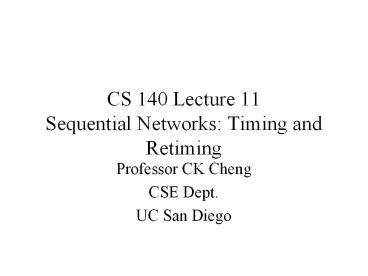CS 140 Lecture 11 Sequential Networks: Timing and Retiming - PowerPoint PPT Presentation
Title:
CS 140 Lecture 11 Sequential Networks: Timing and Retiming
Description:
Setup time: tsetup = time before the clock edge that data must be stable (i.e. not changing) ... Setup Time Constraint. The setup time constraint depends on the ... – PowerPoint PPT presentation
Number of Views:90
Avg rating:3.0/5.0
Title: CS 140 Lecture 11 Sequential Networks: Timing and Retiming
1
CS 140 Lecture 11Sequential Networks Timing and
Retiming
- Professor CK Cheng
- CSE Dept.
- UC San Diego
2
Sequential Networks
Timing Setup Time and Hold Time Constraints
Q Q
D
CLK
3
Sequential Networks
Combinational
D
B
C
A
CLK
CLK
A typical sequential network has both a
combinational circuit and flip-flips.
4
Combinational
B
C
A
CLK
CLK
tcq tcomb tsetup lt T thold lt tcq tcomb
Clock period
Shortest path
5
Input Timing Constraints
- Setup time tsetup time before the clock edge
that data must be stable (i.e. not changing) - Hold time thold time after the clock edge that
data must be stable - Aperture time ta time around clock edge that
data must be stable (ta tsetup thold)
6
Output Timing Constraints
- Propagation delay tpcq time after clock edge
that the output Q is guaranteed to be stable
(i.e., to stop changing) - Contamination delay tccq time after clock edge
that Q might be unstable (i.e., start changing)
7
Dynamic Discipline
- The delay between registers has a minimum and
maximum delay, dependent on the delays of the
circuit elements
8
Setup Time Constraint
- The setup time constraint depends on the maximum
delay from register R1 through the combinational
logic. - The input to register R2 must be stable at least
tsetup before the clock edge.
Tc tpcq tpd tsetup tpd Tc (tpcq
tsetup)
9
Hold Time Constraint
- The hold time constraint depends on the minimum
delay from register R1 through the combinational
logic. - The input to register R2 must be stable for at
least thold after the clock edge.
thold lt tccq tcd tcd gt thold - tccq
10
Timing Analysis
Timing Characteristics tccq 30 ps tpcq 50
ps tsetup 60 ps thold 70 ps tpd 35
ps tcd 25 ps
tpd tcd Setup time constraint Tc fc
1/Tc
Hold time constraint tccq tpd gt thold ?
11
Timing Analysis
Timing Characteristics tccq 30 ps tpcq 50
ps tsetup 60 ps thold 70 ps tpd 35
ps tcd 25 ps
tpd 3 x 35 ps 105 ps tcd 25 ps Setup time
constraint Tc (50 105 60) ps 215 ps fc
1/Tc 4.65 GHz
Hold time constraint tccq tpd gt thold ? (30
25) ps gt 70 ps ? No!
12
Fixing Hold Time Violation
Timing Characteristics tccq 30 ps tpcq 50
ps tsetup 60 ps thold 70 ps tpd 35
ps tcd 25 ps
Add buffers to the short paths
tpd tcd Setup time constraint Tc fc
Hold time constraint tccq tpd gt thold ?
13
Fixing Hold Time Violation
Timing Characteristics tccq 30 ps tpcq 50
ps tsetup 60 ps thold 70 ps tpd 35
ps tcd 25 ps
Add buffers to the short paths
tpd 3 x 35 ps 105 ps tcd 2 x 25 ps 50
ps Setup time constraint Tc (50 105 60)
ps 215 ps fc 1/Tc 4.65 GHz
Hold time constraint tccq tpd gt thold ? (30
50) ps gt 70 ps ? Yes!
14
Clock Skew
- The clock doesnt arrive at all registers at the
same time - Skew is the difference between two clock edges
- Examine the worst case to guarantee that the
dynamic discipline is not violated for any
register many registers in a system!
15
Setup Time Constraint with Clock Skew
- In the worst case, the CLK2 is earlier than CLK1
Tc tpcq tpd tsetup tskew tpd Tc (tpcq
tsetup tskew)
16
Hold Time Constraint with Clock Skew
- In the worst case, CLK2 is later than CLK1
tccq tcd gt thold tskew tcd gt thold tskew
tccq
17
Timing and Retiming
- Retiming Adjust the clock skew so that the clock
period can be reduced. - Add a few more examples on timing and retiming.































